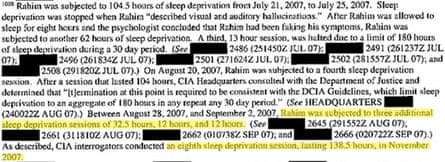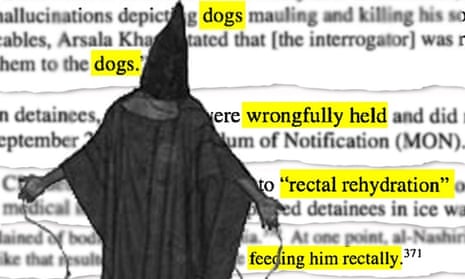A prosecutor’s Eureka moment: I never got specifics because they didn’t exist
[A]ccording to CIA records, seven of the 39 CIA detainees known to have been subjected to the CIA’s enhanced interrogation techniques produced no intelligence while in CIA custody. (page 9)
I spent five years prosecuting war crimes cases at Guantánamo Bay. While we could not use evidence in court derived from torture or abusive treatment, I questioned why maltreatment was used in the first place. The answer was always this: “Torture works. Torture saves lives.” As a prosecutor, I was never provided with any specifics. After reading the Senate’s report, I now understand why: they didn’t exist. No terror plot was stopped due to abusive interrogations. This was my Eureka moment after reading the report.
The very first Senate finding I stumbled across was right there on Page 9 – and it completely refutes the official justification for using torture. “[N]o intelligence while in CIA custody”? It is the first finding, and it is a blockbuster. If torture does not lead to actionable intelligence and does not stop terrorist acts, then why use it at all? Shouldn’t we have used traditional, rapport-based interrogation techniques such as the FBI agents who questioned Abu Zubaydah? The suspect was cooperating until the CIA’s contractors started waterboarding Abu Zubaydah in detention for 17 days, until he became “completely unresponsive”.
In standard criminal cases, you can’t torture suspects to obtain a suspect’s confession because the information is inherently untrustworthy. Sometime after 9/11, our intelligence officers refused to believe that bothersome truth. —David Iglesias, retired from the Navy Reserve Jag captain, former US Attorney, director of J Dennis Hastert Center at Wheaton College
From a former interrogator: it’s as if they deliberately avoided expertise

This is shocking. Prior to 9/11, the US military and the FBI had considerable experience in interrogating and investigating Islamic extremists in the aftermath of the Khobar Towers bombing, the USS Cole Bombing, and the first World Trade Center bombing – as well as numerous other counterterrorism operations.
It’s as if the designers of the torture program deliberately avoided expertise that would have steered them away from coercive interrogation techniques. It makes me question whether the techniques were ever about getting intelligence – or just exacting punishment. One of the arguments of the torture defenders has been that they tried the rapport-building techniques of the military and FBI – but that they didn’t work.
The report makes it clear that this was a lie.
As we know from the testimony of Ali Soufan, the former FBI agent who interrogated Abu Zubaydah, rapport-based techniques were working before the CIA interfered and applied torture. It’s also clear that CIA never consulted military or FBI interrogators who could have helped them improve the humane, non-coercive techniques that proved successful during the Gulf War, or as far back as World War II, for that matter.
It’s as if they purposefully avoided knowledge of the long history of successes that interrogators have achieved from the 1940s until now.
That is a shame.
But let’s not forget: the report only examines the CIA’s program – and many of the critiques could also be said of the US military’s own use of torture and coercion when many of these same techniques were approved by former Secretary of Defense Donald Rumsfeld and were applied to hundreds, perhaps thousands of detainees, not the very limited 119 examined by the Senate report.
While we try to comprehend and digest the aberration that was the CIA’s program, let’s not forget that the US military’s transgressions were far more widespread. And for that, we have no comprehensive report. —Tony Camerino, former senior military interrogator
Human rights violations, rewarded with CIA cash

This is a particularly despicable and illuminating look into how the CIA treated its officers who were carrying out torture techniques. After a detainee, Gul Rahman, was chained, nearly naked, to a concrete floor for an extended time and then froze to to death, no officer on-site nor at the CIA was disciplined – let alone prosecuted. In fact, the CIA officer in charge of the detention site was recommended to receive a bonus of $2,500 for his “consistently superior work”. Five pages earlier in the report, we are told that this particular CIA officer was already known for dishonesty and lack of judgment when he was sent on his first overseas assignment to head this detention site. Eleven years and one page in the report later, the CIA acknowledged it “erred” in not holding anyone accountable for Rahman’s death.
Eleven years.
When a government agency disregards human life so recklessly – and even considers rewarding those on the payroll who do the same – how is it possible to believe the United States can maintain the illusion of being a human rights champion? President Obama and Congress must ensure accountability – including prosecutions, as well as reparations for victims – and not just for torture but enforced disappearances and other human rights violations that leave the US in serious violation of its international legal obligations. —Steven W Hawkins, executive director, Amnesty International USA
Doctors were used to create a fiction of safe, legal and effective

CIA records detail how throughout the program, CIA medical personnel cleared detainees for the use of the CIA’s enhanced interrogation techniques and played a central role in deciding whether to continue, adjust, or alter the use of the techniques against detainees. (page 516)
The Senate’s report confirms what we’ve long known: the United States systematically tortured detainees, sometimes to the point of death, and relied on the complicity of health professionals to commit and conceal these crimes.
Psychologists developed and actively participated in the CIA’s torture methods, and both psychologists and doctors were used to create a fiction of “safe, legal, and effective” interrogation practices. In reality, health professionals monitored and calibrated the infliction of severe physical and mental pain, withheld medical treatment, and failed to document medical evidence of intentional harm.
Torture is always illegal and immoral and, as the report shows, it provided little to no actionable intelligence. It compromised everything the United States stands for as a country based on the rule of law, but torture betrayed the core tenet of the healing professions – to do no harm.
The report is a critical step in establishing a public record of the nature and extent of CIA torture, but the question remains: Will those responsible for the authorization and implementation of torture be held accountable to ensure that these crimes never happen again? —Dr Vincent Iacopino, senior medical advisor, Physicians for Human Rights
Anal probes as punishment for hunger-striking? So how is force-feeding not torture now?

While the torture report provides many new horrifying details, the saddest part is that even those who championed this much-needed report have failed to respond to its lessons going forward. Consider how casually the report describes that Abd al Rahim al-Nashiri – the alleged mastermind of the USS Cole bombing – went on a hunger strike.
As if the response to a hunger strike should ever be to feed someone rectally!
Indeed, the comment – and the evidence such “rectal feeding” left on his body, suggests that Nashiri was anally probed as punishment for hunger-striking. Indeed, a doctor who recently testified about Nashiri’s torture as part of his military commission testified that he had the kind of “anal-rectal complaints” that “survivors of sexual assault experience”.
Yet this strong suggestion that the US government has used “force-feeding” as an excuse to punish hunger-strikers has not led the Senate Intelligence Committee or Senate Armed Services Committee to act more assertively against punitive force-feeding currently going on at Guantánamo Bay. While Senator Dianne Feinstein has repeatedly sent letters to object to the coercive and painful methods the Pentagon uses to force-feed hunger strikers, she is not known to have done more, such as hold a hearing on the practice.
Lawyers for Gitmo detainees, especially for the recently released Abu Wa’el Dhiab, argue the method used for force-feeding hunger-strikers amounts to to torture. Given the apparent use of force-feeding as torture in the past, that claim should receive renewed attention. —Marcy Wheeler, independent journalist at Emptywheel
Back and forth with lies against lies, all for nothing on KSM

According to cables, crying, al-Barq then said ‘I made the anthrax.’ Asked if he was lying, al-Barq said that he was. After CIA interrogators ‘demonstrated the penalty for lying,’ al-Barq again said ‘I made the anthrax’ and then immediately recanted, and then again stated that he made anthrax. Two days later, al-Barq stated that he had lied about the anthrax production ‘only because he thought that was what interrogators wanted.’ (pages 82-83)
This passage is the one that most perfectly summarizes the brutality, inhumanity and absurdity of torture. After 10 years of working on CIA abuses, I didn’t know it was possible to be shocked but not surprised.
We already knew of the brutal stress positions, forced standing, waterboarding and extended sleep deprivation with light and noise; now we know about the use of punitive “anal feeding” or “anal rehydration”, about forcing detainees with broken leg bones to stand shackled against a wall. Now we know about all the lies.
The text above is from Footnote 442, concerning whether actionable intelligence was obtained from Khalid Sheikh Mohammed (KSM), the alleged facilitator of the 9/11 attacks. It concerns the interrogation of a man, Samr al-Barq, whom KSM said had supposedly worked on a team tasked with creating anthrax for al-Qaida.
“Samr al-Barq told CIA interrogators that ‘we never made anthrax’,” the report reads. Under enhanced interrogation techniques, he “was told that the harsh treatment would not stop until he ‘told the truth’.” So he said he did make anthrax, and then that he didn’t, that he did, and that he didn’t – back and forth with lies against lies until it was all without purpose. He was released a few months later. —John Sifton, Asia advocacy director, Human Rights Watch
...and the last detainee, buried in Footnote No 1,008

This passage describes, in graphic detail, the treatment of CIA detainee Muhammad Rahim. Rahim was captured in July 2007 – after John McCain ensured passage of legislation banning the CIA from engaging in cruel treatment, after the Supreme Court ruled that Article 3 of the Geneva Conventions protected every prisoner in U.S. custody.
As you read between the redactions of Rahim’s treatment, bear in two things in mind:
- The CIA carried out sleep deprivation by means of shackling diapered detainees to the ceiling.
- The Office of Legal Counsel concluded that not only was Rahim’s treatment not torturous or cruel, but it complied with Common Article 3 of the Geneva Conventions.
According to the report, after all of this treatment, Rahim produced “no intelligence” (page 163). At one point, former clandestine service chief and torture tape disintegrator Jose Rodriguez wrote to CIA director Michael Hayden that “I do not concur with extending Rahim’s detention for another 60 days. I do not believe the tools in our tool box will allow us to overcome Rahim’s resistance techniques” (page 166).
Of all the cases in this report, Rahim’s may do the most to prove that Congress needs to act to prevent the CIA and US attorneys from ever again secretly evading the laws against torture. Remember the last detainee. —Katherine Hawkins, national security fellow, Open the Government
